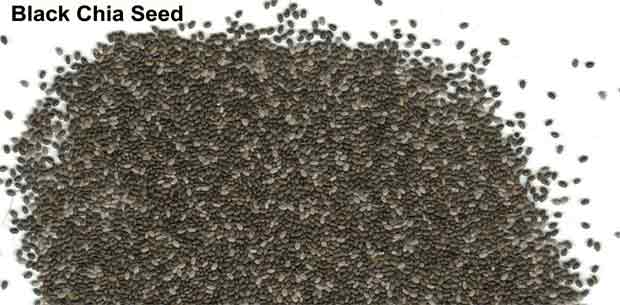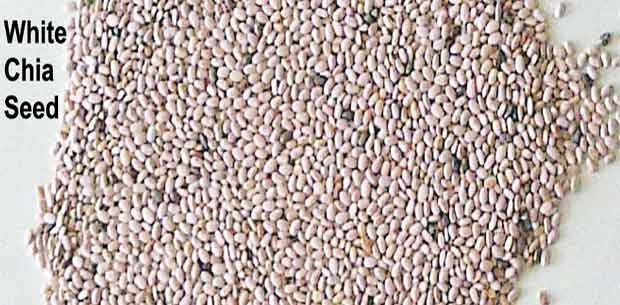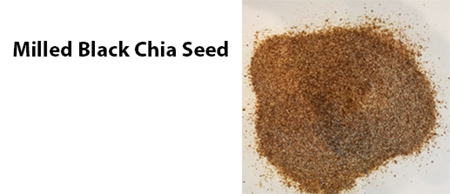Chia seed nutrient composition and its relation with human daily nutrient requirements
Ing. Ricardo Ayerza (h)
The Office of Arid Lands Studies
The University of Arizona
(June 29, 2003)
Introduction
The following discussion is intended to make it easier to understand the nutritional composition of chia seeds in relation to the nutritional recommendations that are being made and which will contribute to a healthy diet.
Daily value
Percentage of daily value (%DVs) are based on recommendations for a 2,000 calorie diet. For labeling purposes, the U.S. Food and Drug Administration set 2,000 calories as the reference amount to calculate %DVs. The %DV shows the percentage (or how much) of the recommended daily amount of a nutrient is in a serving of food. By using the %DV, you can tell if this amount is high or low. Your actual daily values may be higher or lower depending on your calorie needs, since if you are like most people, may not know how many calories you consume in a day. Still you can still use the %DV as a frame of reference, whether or not you eat more or less than 2,000 calories each day.
Serving size
The size of the serving on the food package affects the nutrient amounts listed on the label. A 25 gr. serving size is based on the daily amount of omega-3 fatty acid recommended by a number of nutrition organizations such as the Food and Agricultural Organization/World Health Organization (2002), British Nutrition Foundation (1999) and Health and Welfare Canada (1990), and on the results of the trial which determined the total cholesterol, LDL, HDL, and triglycerides effects in humans, following chia seed consumption (Coates and Ayerza, 2002).
Serving per container
The number of servings per container, four and ten for 100 and 250 gr. containers, respectively, is based on the chia seed packages already in the market.
Content claims
Nutrient content claims of the Nutritional Facts Panel makes it easy to distinguish one claim from another, when comparing different products. The chia seed content claims were set up using the classification system developed by The National Academy of Science (1999, 2000) and the US Food and Drug Organization (1999). However, as these two organizations have not determinated daily recommendations for omega-3 fatty acid values, the values and content claims for these were set up using the officially recommended minimal nutrient intakes established by Health and Welfare Canada (1990).
Nutritional Facts Panel
|
Chia Seeds |
||||
|
Nutrition Facts |
||||
|
Serving size: 25 gr Serving per container: 4 (100 gr container); 10 (250 gr container) |
||||
|
Total calories 134 |
Calories from fat 73.8 |
|||
|
Amount per serving |
25 gr/day |
DV gr |
% DV |
Content claims |
|
Cholesterol |
0 |
300 mg |
Free |
Free |
|
Sodium |
<5 mg |
2400 mg |
Free |
Free |
|
Total fat |
8.2 gr |
65 gr |
12.6 |
—– |
|
Saturated fat |
0.7 gr |
20 gr |
3.5 |
Low saturated fat |
|
Trans fatty acids |
0 |
—– |
—– |
Free |
|
Omega-3 fatty acids |
5.2 gr |
1.3 gr |
400 |
Source of omega-3 |
|
Protein |
4.3 gr |
50 gr |
8.6 |
|
|
Total carbohydrate |
11.0 gr |
300 gr |
3.7 |
|
|
Dietary fiber |
6.9 gr |
25 gr |
27.6 |
High |
|
Niacin |
1.6 mg |
16 mg |
10 |
Good source |
|
Riboflavin (B2) |
0.01 mg |
1.3 mg |
< 1 |
—- |
|
Thiamin (B1) |
0.05 mg |
1.2 mg |
4.2 |
—- |
|
Vitamin A |
11 I.U. |
5000 I.U. |
< 1 |
—- |
|
Calcium |
205 mg |
1000 mg |
20.5 |
High |
|
Phosphurus |
231 mg |
700 mg |
33 |
High |
|
Magnesium |
98 mg |
420 mg |
23.3 |
High |
|
Manganese |
1.46 mg |
2.3 mg |
63.5 |
High |
|
Zinc |
1.7 mg |
11 mg |
15.5 |
Good source |
|
Copper |
0.53 mg |
2.0 mg |
26.5 |
High |
|
Potassium |
175 mg |
3500 mg |
5.0 |
—- |
|
Iron |
4.1 mg |
18 mg |
22.8 |
High |
|
Molybdenum |
0.05 mg |
0.075 mg |
66.7 |
High |
|
Aluminum |
0.5 mg |
—– |
—– |
|
|
Boron |
0.35 mg |
—– |
—– |
|
Nutrition Fact Comments
The nutrients
|
Limit these: The nutrients listed first are the ones Americans and other Western Countries people generally eat in adequate amounts, or even too much. They are identified in brown on the chart as Limit these Nutrients. Eating too much fat, saturated fat, trans fatty acids or too much sodium increase your risk of certain chronic diseases, like heart disease, some cancers, or high blood pressure. Eating too many calories is linked to overweight and obesity. Chia seeds are free of sodium, cholesterol, and trans fatty acids, and low in saturated fat content. |
|
Get enough of these: Americans often don’t get enough dietary fiber, vitamin A, vitamin C, calcium, and iron in their diets. They are identified in blue on the chart as Get Enough of these Nutrients. Eating enough of these nutrients can improve your health and help reduce the risk of some diseases and conditions. For example, getting enough calcium can reduce the risk of osteoporosis, in which bones become brittle and break as one ages. Chia seed are a high source of dietary fiber, calcium, phosphorus, magnesium, manganesum, cooper, iron and molybdenum, and a good source of niacin and zinc, and a source of omega-3 fatty acids. |
Healthy food
Chia seed is considered a Food Supplement by the FDA, however, it meets the food nutrient content regulations established by this organization, and hence can be claimed as a “healthy food” (FDA, 1999).
References
British Nutritional Foundation. 1999. N-3 fatty acids and health. British Nutrition Foundation, Briefing paper, London, U.K., 44 p.
Canada [dept of] Health and Welfare. 1990. Nutrition recommendation. Canadian Government Publishing Center, Ottawa, Canada.
Food and Nutrition Division. 2002. Human vitamin and mineral requirements. Food and Agricultural Organization and World Health Organization, Rome, Italy, 312p.
National Academy of Science. 2001. Dietary reference intakes for vitamin A, vitamin K, arsenic, boron, chromium, cooper, iodine, iron, manganese, molybdenum, nickel, silicon, and vanadium. The National Academy Press, Wasingthon D.C., USA., 800p.
National Academy of Science. 1999. Dietary reference intakes for thiamin, riboflavin, niacin, Vitamin B6, folate, vitamin B12, pantothenic acid, biotin, and choline. The National Academy Press, Wasingthon D.C., USA., 592p.
U.S. Food and Drug Administration. 1999. The food label. Download from the www.fda.gov on







